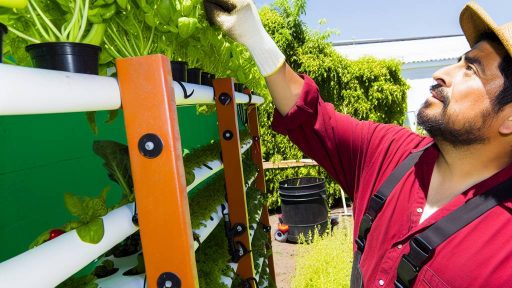Understanding Microgreens and Their Benefits
What Are Microgreens?
Microgreens are young plants harvested at an early stage of growth.
They typically measure between one and three inches tall.
Common varieties include arugula, radish, and basil.
Health Benefits of Microgreens
Microgreens are packed with nutrients and flavor.
They often contain higher concentrations of vitamins and minerals than mature plants.
Additionally, they are rich in antioxidants, supporting overall health.
Environmental Benefits
Microgreens are environmentally friendly to grow.
They require less water and space compared to conventional crops.
Moreover, they can be cultivated indoors, reducing transport emissions.
Economic Advantages
Microgreens offer profitable opportunities for farmers and entrepreneurs.
They grow quickly, allowing for rapid harvest cycles.
Due to high market demand, selling microgreens can yield good returns.
Culinary Versatility
Microgreens add flavor and visual appeal to various dishes.
Chefs and home cooks alike enjoy their vibrant colors and textures.
They can enhance salads, sandwiches, and garnishes beautifully.
Transform Your Agribusiness
Unlock your farm's potential with expert advice tailored to your needs. Get actionable steps that drive real results.
Get StartedFactors to Consider When Choosing Seeds for Microgreens
Seed Variety
Selecting the right seed variety is crucial for high-yield microgreens.
Popular options include radish, pea, and sunflower seeds.
These varieties provide rapid growth and robust flavors.
Additionally, explore unique options like mustard and beet seeds for diversity.
Germination Rate
The germination rate influences your overall yield.
Higher germination rates lead to denser crops.
Make sure to choose seeds with a germination rate above 85%.
Check seed packets or consult suppliers for this information.
Days to Harvest
Different seeds have varying days to harvest.
Quick-growing varieties like broccoli can be ready in as little as 7 days.
In contrast, some varieties may take up to 21 days.
Knowing your timeline can help you plan effectively.
Flavor and Quality
The flavor profile is essential when selecting microgreens.
Consider the taste preferences of your target market.
Seek seeds known for their vibrant flavors, such as basil and arugula.
Quality also impacts your marketability and customer satisfaction.
Seed Sourcing
Finding reputable suppliers is key to successful microgreens farming.
Look for suppliers that offer organic and non-GMO seeds.
Research reviews and ratings to ensure quality and reliability.
Establishing a relationship with trusted suppliers can provide ongoing support.
Pest and Disease Resistance
Select seeds that exhibit resistance to pests and diseases.
Resistant varieties can minimize losses and reduce chemical use.
Consult gardening resources for information on disease-resistant options.
Prioritize health and sustainability in your choices.
Showcase Your Farming Business
Publish your professional farming services profile on our blog for a one-time fee of $200 and reach a dedicated audience of farmers and agribusiness owners.
Publish Your ProfileTop Varieties of Seeds for High-Yield Microgreens
Popular Seed Choices
Many gardeners choose radish seeds for high yields.
These seeds germinate quickly and produce vibrant microgreens.
Another favorite is sunflower seeds, known for their rich flavor.
Sunflower microgreens also boast excellent nutritional value.
Pea shoots are equally popular among microgreen enthusiasts.
Their sweet taste adds freshness to various dishes.
Basil seeds offer a unique option with aromatic leaves.
This variety is perfect for adding a culinary touch to plates.
Seed Quality and Source
Choosing high-quality seeds is essential for success.
Look for reputable suppliers known for organic seeds.
Certifications can indicate the quality of the seeds.
Consider local suppliers for fresh, region-specific varieties.
Additionally, research can help identify the best sources.
Yield Considerations
High-yield microgreens require the right conditions.
Ensure proper light, temperature, and moisture levels.
Some seeds naturally produce larger yields than others.
For instance, broccoli seeds often deliver substantial harvests.
Experimenting with different varieties can yield surprising results.
Market Demand and Culinary Uses
Understanding market demand helps in seed selection.
Popular microgreens include arugula, beets, and mustard greens.
These varieties cater to the culinary scene’s evolving tastes.
By staying informed, you can grow what customers want.
Culinary trends often highlight unique microgreens in dishes.
Adapt your crops to suit these trends for higher sales.
See Related Content: Seasonal Gardening for Drought-Resistant Crops
How to Source Quality Seeds for Microgreens Farming
Understanding Seed Quality
Quality seeds are crucial for successful microgreens farming.
They directly affect yield and plant health.
To ensure high-quality growth, consider seed origin.
Choose seeds from reputable suppliers.
Look for seeds certified for microgreens.
Evaluating Seed Suppliers
Research potential suppliers thoroughly before purchasing.
Check online reviews and testimonials.
A reputable supplier will provide detailed product information.
Ask for germination rates and test results.
This data can indicate seed viability.
Choosing Suitable Seed Varieties
Select seed varieties known for high yields.
Popular options include radish, sunflower, and pea.
Consider taste and nutritional value when choosing varieties.
Both flavor and health benefits contribute to market appeal.
Organic and Non-GMO Options
Organic seeds promote sustainable microgreens farming practices.
Showcase Your Farming Business
Publish your professional farming services profile on our blog for a one-time fee of $200 and reach a dedicated audience of farmers and agribusiness owners.
Publish Your ProfileThey also appeal to health-conscious consumers.
Look for labels that specify non-GMO status.
This ensures your crop meets growing market demands.
Storage and Handling Practices
Proper storage can maintain seed quality over time.
Store seeds in a cool, dry place to extend shelf life.
Avoid exposure to direct sunlight and moisture.
Additionally, keep them in airtight containers.
Testing Germination Rates
Before large-scale planting, conduct a germination test.
This process ensures your seeds are viable.
Use a small sample of seeds from each batch.
Follow simple procedures to assess germination success.
Building Relationships with Local Growers
Connect with local growers for seed recommendations.
They can share valuable experiences and insights.
Attend local farming events to network and learn.
Building a strong community supports better farming practices.
Learn More: DIY Garden Projects for Greenhouse Farming
The Importance of Seed Germination Rates
Seed germination rates play a crucial role in microgreens farming.
High germination rates ensure robust growth and maximize yield.
Farmers must select seeds with proven germination performances.
This process begins with researching different seed varieties.
Some seeds naturally have higher germination rates than others.
For example, pea and radish seeds often germinate well.
Conversely, some seeds may require specific conditions to thrive.
Understanding these requirements can lead to better farming decisions.
Additionally, germination rates can vary by supplier.
Always source seeds from reputable companies.
It is wise to check for user reviews or farmer testimonials.
Many farmers conduct germination tests before large planting.
This practice helps evaluate seed performance efficiently.
Furthermore, maintaining proper storage of seeds contributes to quality.
Humidity and temperature are vital factors in seed longevity.
Seeds stored in optimal conditions typically exhibit higher germination rates.
Monitoring moisture levels can prevent seed deterioration.
After selecting the right seeds, prepare for planting.
Good seedling practices further enhance germination success.
Utilizing quality soil can provide essential nutrients during growth.
Thus, ensuring high germination rates directly influences profitability.
Ultimately, your choice of seeds lays the foundation for your success.
Uncover the Details: Sustainable Agroforestry Practices for Small-Scale Farmers

Growing Conditions and Their Impact on Seed Selection
Understanding Growth Environment
The growing environment significantly influences seed selection for microgreens.
Showcase Your Farming Business
Publish your professional farming services profile on our blog for a one-time fee of $200 and reach a dedicated audience of farmers and agribusiness owners.
Publish Your ProfileTemperature, light, humidity, and airflow all play crucial roles.
A proper understanding of these factors will guide your decisions.
Temperature Requirements
Most microgreens thrive in temperatures between 65°F and 75°F.
Extreme temperatures can stunt growth or lead to seed failure.
Choose heat-resistant seeds if your climate exceeds these limits.
Light Conditions
Microgreens require ample light for healthy growth.
Consider using grow lights in lower light environments.
Select seeds that grow well in low light if necessary.
Humidity Levels
Humidity impacts seed germination and growth rates.
A humidity level between 40% and 60% is typically ideal.
Keep an eye on moisture levels to avoid fungal diseases.
Airflow Considerations
Proper airflow helps prevent mold and promotes healthy plants.
Ensure adequate ventilation, especially in high-density setups.
Choose seeds that can adapt to varying airflow conditions.
Soil Type and Nutrient Availability
The soil type affects the nutrient availability for microgreens.
Use a well-draining soil mix enriched with organic matter.
Research which seeds thrive best in your chosen soil type.
Watering Practices
Watering is critical for microgreens, impacting their growth rates.
Overwatering can lead to root rot, so be cautious.
Select seeds that can tolerate your specific watering methods.
Pest and Disease Resistance
Consider pests and diseases that may affect various seeds.
Some seeds are naturally more resistant to common issues.
Research pest-resistant varieties to simplify management.
Explore Further: The Role of Microgreens in Sustainable Urban Farming Practices
Organic vs. Conventional Seeds: Which is Better for Microgreens?
Understanding Seed Types
Microgreens can be grown from organic or conventional seeds.
Choosing the right type impacts growth and health.
Organic seeds come from plants grown without synthetic fertilizers.
Conversely, conventional seeds may be treated with chemicals.
Benefits of Organic Seeds
Organic seeds support sustainable farming practices.
They foster biodiversity and encourage soil health.
Moreover, organic seeds often yield vibrant, nutrient-rich crops.
Farmers using organic seeds can appeal to health-conscious consumers.
Limitations of Organic Seeds
Organic seeds can sometimes be more expensive than conventional ones.
Additionally, they may have lower germination rates under certain conditions.
Farmers might face challenges sourcing a variety of organic seeds.
Advantages of Conventional Seeds
Conventional seeds are typically more affordable and accessible.
They often exhibit faster germination and growth rates.
Farmers can readily find a diverse range of conventional seed options.
This type may perform better in various climates and conditions.
Potential Downsides of Conventional Seeds
Conventional seeds may contain chemical treatments that some consumers avoid.
Showcase Your Farming Business
Publish your professional farming services profile on our blog for a one-time fee of $200 and reach a dedicated audience of farmers and agribusiness owners.
Publish Your ProfileThese treatments can affect the taste and nutritional value of the microgreens.
Moreover, reliance on these seeds may harm long-term soil health.
Making the Right Choice
Deciding between organic and conventional seeds depends on your goals.
Consider your target market and consumer preferences.
Also, evaluate the growing conditions and your budget constraints.
Ultimately, both seed types have unique advantages and disadvantages.
Understanding these aspects will help you make an informed decision.
Common Mistakes to Avoid When Selecting Seeds for Microgreens
Ignoring Seed Quality
Always prioritize seed quality when starting your microgreens farm.
Low-quality seeds can lead to poor germination rates.
Check for reputable suppliers and certifications.
Additionally, verify that seeds are specifically meant for microgreen farming.
Neglecting to Consider Flavor and Aroma
The flavor and aroma of microgreens can significantly impact your final product.
Choose varieties known for their strong flavors.
Popular choices include basil, cilantro, and radish microgreens.
These options enhance dishes and attract customers.
Overlooking Growth Requirements
Different microgreens have distinct growth requirements.
Consider sunlight, humidity, and temperature needs for each variety.
For example, some may require more light than others.
Research these needs before making seed selections.
Failing to Test Germination Rates
Testing germination rates before planting can save time and resources.
Conduct small tests with purchased seeds first.
This helps predict how well your chosen variety will perform.
Moreover, high germination rates indicate better chances for success.
Not Diversifying Seed Choices
Limiting your seed selection can reduce potential profits.
Diverse offerings attract a broader customer base and boost sales.
Consider mixing common varieties with unique options.
This strategy enhances your market appeal.
Disregarding Pesticide Use and Organic Status
Pesticide-free or organic seeds are increasingly preferred by consumers.
Always check the pesticide handling of your seeds.
This choice will influence customer satisfaction and loyalty.
Clearly label your offerings to highlight their organic status.
Additional Resources
Microgreens Farming: Amazing Facts and Reasons to Invest-2023
How Much Does It Cost to Grow Microgreens at Home? • Gardenary




